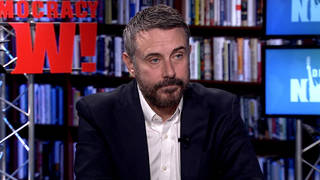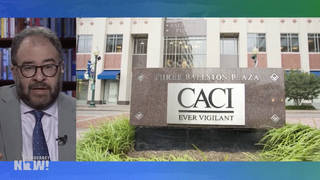
Topics
We speak with Pulitzer prize-winning reporter Seymour Hersh of The New Yorker which just released a series of photos showing what appears to be a dog attacking a naked Iraqi prisoner. And we hear Sen. John McCain questioning Defense Secretary Donald Rumsfeld at the Senate and House Armed Services Committee. [includes rush transcript]
The US military announced this weekend that it would begin its first court martial in the Abu Ghraib prisoner abuse scandal since graphic images of US personnel abusing Iraqi prisoners were first broadcast April 28th. On May 19, proceedings will begin against Specialist Jeremy Sivits, who is a member of the 372nd Military Police Company. Brig. Gen. Mark Kimmitt made the announcement in the Iraqi capital and said the proceedings would be held in the Baghdad Convention Center, which houses the coalition press office. Kimmit said the trial will be open to media coverage.
Sivits is one of seven soldiers facing charges but appears to be a lesser figure in the case. He is believed to have taken some of the photos of US personnel abusing the prisoners. Amnesty International has labeled some of the actions depicted in the photos as war crimes, while the Vatican said the conduct of the soldiers at the prison, “offended God.”
Meanwhile, the Bush administration continues to defend Defense Secretary Donald Rumsfeld. Several lawmakers have called for his resignation, while some have gone so far as to begin drafting articles of impeachment against him. In a statement issued late Saturday, Vice President Dick Cheney said, “I think Donald Rumsfeld is the best Secretary of Defense the United States has ever had. People ought to let him do his job.”
On Friday, Rumsfeld spent more than 6 hours in front of the Senate and House Armed Services Committees.
Republican Senator John McCain questioned Rumsfeld on the chain of command at Abu Ghraib and the role of private contractors at the prison.
- Sen. John McCain (R- AZ) questioning Defense Secretary Donald Rumsfeld at the Senate Armed Services Committee Hearing on May 7, 2004.
One of the most talked about statements made by Rumsfeld during his appearances on Capitol Hill Friday was that the photos currently in the public domain are just a fraction of the videos and pictures of US personnel abusing Iraqi prisoners. The Pentagon is fighting to keep these images from reaching the public and has been negotiating with Congress in an effort to keep them sealed. But more images continue to emerge. The New Yorker magazine just released a series of photos showing what appears to be a dog attacking a naked Iraqi prisoner. The photos are part of the latest article by Pulitzer prize winning journalist Seymour Hersh. It’s called called “Chain of Command.”
- Seymour Hersh, Pulitzer Prize winning journalist for the New Yorker.
Transcript
AMY GOODMAN: Last night, I spoke with Seymour Hersh about his piece.
SEYMOUR HERSH: The most important thing I covered is that most of the people in the chain of command weren’t really informed about what was going on. People that normally would have been alerted to the problems they had, at the prison in Iraq, the Abu Ghraib prison, were not clued in. It seems as if the administration simply — it’s not even a cover-up. It’s so much more profound than that. What they do in this administration at the top is they simply are incapable of dealing with bad news. So here you have this disastrous event come forth. Somebody comes up with the photographs. It’s clear that if this young man and one of the military policemen at the prison hadn’t decided that this was wrong and had not gone into the authorities there I think January the 13th of this year with the photographs, if he had not had the videos or the disks, you know, everything would still be a exactly the way it was. Janice Karpinski, the general who ran that brigade would be doing it, and the abuses would probably still be going on. But he had the video. So, they had to act. And so, it gets briefed into Washington. And here you have this sort of amazing freight train coming down the road from January on, and the highest powers in this administration, Rumsfeld and Wolfowitz and the president, they are just running around rearranging the deck chairs on the Titanic, any cliché that you want. That is simply because it’s something they couldn’t deal with. And then in talking to officers and actually when I had known for a long time, some of the — for example, the GCS and army planners have been trying to tell the — Rumsfeld and others for a year how bad things were going and how much — how wrong the estimates are about troops strengths and what’s needed. And you can’t get them to listen. They only listen to their own little voices, I guess. It’s really amazing. And you can understand this sort of inability to hear, this self-deception they practice. They really — I think some of them may really believe six or seven bad seeds, six or seven bad kids are responsible for what happened in the prison system and that the idea that there’s something systematic and something they may have inadvertently or advertently, we don’t know yet, started.
AMY GOODMAN: Pulitzer Prize winning reporter Seymour Hersh. We will talk with him about the latest picture that has been released in a minute.
AMY GOODMAN: This is Democracy Now!, Saul Williams, “Not in my name.”, the war and peace report. Looking at Pulitzer Prize winning reporter, Seymour Hersh’s article in today’s “New Yorker” magazine called “Chain of Command, How the Department of Defense Mishandled the Disaster at Abu Ghraib,” he writes one of the new photographs shows a young soldier wearing a dark jacket of his uniform, smiling into the camera in the corridor of the jail. In the background are two army dog handlers in full camouflage combat gear restraining two German shepherds. The dogs are barking at a man who is partly obscured from the cameras view by the smiling soldier. Another image shows that the man, an Iraqi prisoner is naked. We spoke to Seymour Hersh last night about the photo.
SEYMOUR HERSH: There were two dogs. They there were about 20 that I saw altogether. They were taken by two different cameras over 12 minutes. And one was quite — the one that the “New Yorker” published was quite graphic, but they show this — what can I tell you, this terrified man, you know, we have seen pictures like that before in Mississippi during the civil war days — the civil rights marches and in World War II, we have seen photographs like that. But American military policemen and intelligence officers doing that, I quote one general, retired major general, a man named Heinz that ran the military police, that was in police business for 28 years as an army officer. He said if he had ever done anything like that, he would have been kicked out of the army. This is six or seven years or more back. The progression shows that he’s terrified and eventually we don’t see the dogs biting him and we see him on the ground, a lot of blood around him and a large gash in his foot, in his thigh rather up the thigh. And so it’s clear that the dog bit him, although we don’t actually see it in the 20 or so shots I have, but you know, the thing that’s amazing about it — there are two interesting things about it. Well, actually, three, really. One, of course, is, it’s just another day on the job for everybody. Nobody is stopping. There’s for our five people around and some of the photos. There were two cameras, going, as I said, which means two people were filming, not just one. There’s more than just casual photography business. I think it’s part of the interrogation process. And three was really much more interesting in terms of the army’s — and the White House’s insistence that this is just a few. It’s a different group of men and women, the other — the six or seven people that are undergoing investigation and possible criminal sanctions right now are all from a company known as the 372nd military police, MP company. These slides and snapshots came from someone in the 320th MP battalion, a different group, same prison. Same probably area of the prison, but nonetheless, a different organization, a different unit. So the idea that what was going on there was limited to one unit is wrong. And then elsewhere in the story I did, I quoted another — I don’t quote him by name, but another young captain who ran a military police company at yet another prison at roughly the same time this was last fall. These photographs were taken — the ones in the photograph in the “New Yorker” this week was — I think was taken the night or evening of December 2nd or late afternoon, December 12, rather, last year. But at that same time, and in a prison, you know, near Baghdad, yet at another facility, the same sort of pressure was being put on by the military intelligence people. So, what you are seeing is, you are beginning to see evidence — the photographs are evidence, which I think they are — of a much more systematic mistreatment of prisoners.
AMY GOODMAN: You also talk about the connections between Iraq, Guantanamo and Afghanistan and talk about how John Walker Lindh was dealt with, the American prisoner who was captured in Afghanistan.
SEYMOUR HERSH: Right, I included the 20 years. Well what is interesting, one of the things in this sort of — I think in this article I described it, the [inaudible], Antonio, the famous group of reports that everybody was talking about and writing about last week. One of the things that he said was very interesting. He had said that the problems in the prison system, as far he can tell, he was brought on to the scene, after the photographs came and he was ordered to do an investigation in late January, which he completed about a month or five or six weeks. But in his report, he said there were two previous studies. In one of them, in one of the studies, another army general had mentioned that this all came out of Afghanistan in project “Enduring Freedom” was the code word. You go back and you then think about that and you look at John Walker Lindh. I talked to his attorney, a man named James Brass in California, who sent me some of the filings on the case, some of the affidavits. You know how the press is when he was around it, was interesting. And once he got — you everybody sort of stopped paying attention to it after a little while. But in one of the affidavits it’s very clear that what happened to him after he was arrested in December 2001, he was stripped and two times over the next few days, people were allowed into take snapshots of a number of photographs were taken of him. In fact, one of them nude ended up being given to one of the networks. So you had a pattern of people photographing you, and also the nudeness and the abusiveness and one of the people, There was I said, there were two investigations. One of the investigations last summer that was done in Iraq on the prison system was done by a man named Jeffrey, Major General Jeffrey Miller who was at that time running the prison in Guantanamo, which is strictly an interrogation facility. And the timeline is this, that by last fall, the American authorities were talking publicly, you know, the insurgency was going and they were talking publicly about 5,000 or so members of the insurgencies, and there’s a tremendous pressure about who are the insurgents, let’s find them and let’s get them. And so, what happened is that — the best guess you have is by late fall, there were as many as 40,000 detainees. They’re not like the people that were taken out of Afghanistan and sent to Guantanamo. Overwhelmingly, 60 or more percentage of them are civilians, people that have nothing — they were just picked up randomly. There’s not much intelligence they get out of them. And anyway there is a separate prison for the hard cases; that we’re not talking about. They weren’t at Abu Ghraib. They were at other places. And so what you were doing is you were trying to find the 5,000 magic guys, and Miller recommended, do so, that you put the military intelligence people last fall in charge of the prisons.
And Ricardo Sanchez — all of this is I write in this article, promulgated an order, they call it a FRAGO, frag operation order, promulgated an order last November 19 putting military intelligence in charge of all the prisons. And that meant that the interrogators — literally that meant you were going to end up with Guantanamos all over the place. Cause whole function of the prison system was getting information. And so the brutality seemed to connect directly with the recommendation of November, December. And so you had a system where — by the way, every expert in interrogation, and anybody in the American government and elsewhere tells you that interrogations by coercion produce nothing because people only tell you what they think you want. They’re the most useless thing. Nonetheless, that seems to have been a widespread decision made, a decision was made and it was decided to escalate the pressure on the people. One of the ways, you know if you are going to humiliate people as they did, as we did, as we know from the photographs, sexually and other ways, it’s — I could tell you right now, I don’t know this empirically, but I have been told by many people that there was nothing — nothing would be as threatening to an Arab men than the idea that you had photographs of him in this horrible position that you could show to friends, neighbors and family. It would be a shaming that would be, you know — a shaming, as shameful and his life would be over in a sense, in terms of his personal integrity in the community. So, out of this, the cameras seem to be much more important, much more systematic. We don’t know the answers to all of these questions. But inevitably you’re led to thinking that what’s happening here is not just something random, but something not only just deliberately or just inadvertently deliberate you know, people come to the same thing at the same place, but there seems to be an overriding system or, you know, a gathering, some notion of how to do it. And therefore, you have some central authority and therefore, somebody like me you seeing it heuristically would say somewhere there’s something going on that we have to find out. There’s some central mechanism for this.
AMY GOODMAN: We’re talking to Pulitzer Prize winning reporter, Seymour Hersh. When did Donald Rumsfeld, the Secretary of Defense learn about this, when did President Bush?
SEYMOUR HERSH: Well, all we can go is by what they say, and we have to take them at their word on this. Because we have no basis otherwise. To give you some idea and here is the irony — this is the — this is confusing to me and should be confusing to everybody. The January 13, the photographs come out. We know now that by 2:30 the next morning — this is from accounts of the various people who were being prosecuted, one of them in letters home, by 2:30 the next morning, he was rousted out by the army police, C.I.D., the criminal investigation division, who are pretty straight guys. They do their job. They love to burn officers. Anyway, he is rousted out, by 2:30 the next morning they’re on the hunt for people and they are identifying people on the photographs. Within — Rumsfeld just testified by the 16th, that’s two days later, he was notified and he told the president right away. We know by the 19th, General Sanchez ordered an investigation and a few weeks later, he orders Taguba to do his big report. So, within a week, certainly, of the photographs showing up inside this prison at an army criminal investigation division office, within six, seven days, the president knows, Rumsfeld knows, an investigation is begun and the process is underway.
AMY GOODMAN: And again the month and day?
SEYMOUR HERSH: January of — between the 13th and 19th all this happened. Rumsfeld says, no photographs were seen, but certainly, he must have had a very, very explicit account of what — something rational that would make him — compel him — not only had they be worried about enough so they told the Secretary right away, because as he testified there’s 18,000 court-martials in the military system, how am I supposed to know all of them he said at one point in his testimony before Congress last week. Something was special about this right away, but then I think what I’m telling you is the mechanism then is very bad news coming, nobody wants to hear bad news in this administration. So, it just disappears. I know that sounds bizarre, but the disconnects inside this government, particularly on — as we all see in the Iraqi policy, it’s amazing.
AMY GOODMAN: Seymour Hersh, you say that the pictures yet to come unreleased, NBC news quoting U.S. military officials, saying they show American soldiers severely beating an Iraqi prisoner nearly to death, having sex with a female Iraqi prisoner and acting inappropriately with a dead body. The official said there also is a videotape apparently shot by U.S. personnel showing Iraqi guards raping young boys. Where are the videos and photographs?
SEYMOUR HERSH: Well, the army clearly has some of them, but the big fear they have is, you know, this is — this is the CD, NAPSTER-burned CD generation. Before the investigation began in early January, these were being pass around throughout [inaudible], throughout the brigade, the brigade of which Janice Karpinski was — the 800th MP brigade, we’re talking about 3,000 or 4,000 people. God knows how many copies and how many videos are out there. But I think it is fair to say that people will be negotiating with the — with the French photo magazines and the German magazines wherever they can. I don’t think we’re very far away. I don’t know, I can’t tell you that — where the videos are, but I have heard what NBC wrote, I certainly heard and probably worse.
AMY GOODMAN: Did you think anything useful came out of the questioning of Donald Rumsfeld in the Senate and House?
SEYMOUR HERSH: No.
AMY GOODMAN: Do you think that the Senators and the Congress members asked the right questions?
SEYMOUR HERSH: No.
AMY GOODMAN: What would you have asked Donald Rumsfeld?
SEYMOUR HERSH: Oh —
AMY GOODMAN: Will he speak you to?
SEYMOUR HERSH: Now, even though I have known him for 30 years and I have to tell you Donald Rumsfeld is a very bright engaging, interesting man. You can disagree with him all you want, but he’s always bright. He’s the kind of guy that’s always nice to the underlings. He’s always nice to the people that take care of his coats and serve him meals. He’s a very pleasant, amiable, sort of a funny, nice guy. I know I was a reporter during Watergate when I was at the New York Times and I knew him afterwards. And he is funny. The man I see now, I don’t understand. The problem with the kind of show you had last week is you really need to have an underlying basis of information before you ask questions to the Secretary of Defense. I’m talking about in Plato’s cave, in the perfect world, so somebody like me won’t get much of a chance because it’s how you determine something that I may know something and I may know not as much as you, but I may know more than you think I do about this issue. And so it’s always safe for the Senator or Congressman. They rarely — it’s just a useless process. Somebody makes headlines and he did say things. But the message that we have gotten out was pretty much his message, which of course is interesting to me, because we really did a good job on this. Everything is under control. There’s only six or seven people. I think he actually believes it. As I say, this is a guy, telling the band to ply on the Titanic. I’m sure he thinks they can salvage Iraq. I’m sure the president thinks everything is okay. You cannot get the bad news in to them. And the real reality of what this meant, what the photographs mean, you know, it does say an awful lot about Donald Rumsfeld that he wasn’t — he didn’t bother to look at these photographs until just recently.
AMY GOODMAN: And George Bush’s response. First, not being able to bring himself to apologize and standing with King Abdullah, what do you think he needs to do right now?
SEYMOUR HERSH: There’s nothing — this is — there’s no way back on this. This is not just a question of the Arab world being mad at us for the mistreatment or seeing hypocrisy. The Arab world really sees sexual perversion in America. We are talking about the moderate Islamics. They have always had problems with the loose — loose ways of America, you know, and the sexuality and the openness about it. It’s always been very confounding for the average Islamic believer. And now they just see this as a perverse society. I’m saying this on the basis of the conversations with people in that part of the world. The sexual stuff that was done to our men with those women and with the photographs, it’s — for them, it’s just simply perverse. So, I would venture to say you’re going to see a significant drop-off of business and travel and contact with the moderate groups. I think this is a very, very damaging and way beyond Iraq. This is a very damaging event in that part of the world.
AMY GOODMAN: This first man, Jeremy Sivits who will be court-martialed in Baghdad, who is he?
SEYMOUR HERSH: I don’t much about him, he is just one of the six or seven guys that I — the only thing I know about him is I read about him in the Taguba report. He was somebody who was definitely one of the people and the night shift of the person who was engaging in some of the — what really amounts to is torture of the prisoners. The sexual stuff that was being done to them is the form of coercion that is equivalent to torture for those, for those particular individuals. They were being tortured although we didn’t see them and we just saw a lot of awful things, but that was torture.
AMY GOODMAN: You have been listening to Seymour Hersh, Pulitzer Prize winning reporter. Exposed My Lai massacre in Vietnam. His pieces are appearing in the “New Yorker” magazine. This is Democracy Now!.












Media Options